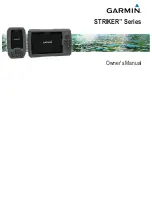
A magenta line appears. In the center of the magenta line is
a thinner purple line that represents the corrected course
from your present location to the destination. The corrected
course is dynamic, and it moves with your boat when you are
off course.
5
Review the course indicated by the magenta line.
6
Follow the magenta line along each leg in the route, steering
to avoid land, shallow water, and other obstacles.
7
If you are off course, follow the purple line (corrected course)
to go to your destination, or steer back to the magenta line
(direct course).
Deleting a Saved Route
1
Select
User Data
>
Routes
.
2
Select a route.
3
Select
Delete
.
Deleting All Saved Routes
Select
User Data
>
Manage Data
>
Clear User Data
>
Routes
.
Track
A track is a recording of the current path of your boat. You can
show your current track in waypoint map view.
Setting the Color of the Track
1
Select
User Data
>
Track
>
Track Options
>
Track Color
.
2
Select a track color.
Clearing the Track
Select
User Data
>
Track
>
Clear Track
>
OK
.
Managing the Track Log Memory During
Recording
1
Select
User Data
>
Track
>
Track Options
.
2
Select
Record Mode
.
3
Select an option:
• To record a track log until the track memory is full, select
Fill
.
• To continuously record a track log, replacing the oldest
track data with new data, select
Wrap
.
Configuring the Recording Interval of the
Track Log
You can indicate the frequency at which the track plot is
recorded. Recording more frequent plots is more accurate but
fills the track log faster. The resolution interval is recommended
for the most efficient use of memory.
1
Select
User Data
>
Track
>
Track Options
>
Record
Intervals
>
Interval
.
2
Select an option:
• To record the track based on a distance between points,
select
Distance
>
Change
, and enter the distance.
• To record the track based on a time interval, select
Time
>
Change
, and enter the time interval.
• To record the track plot based on a variance from your
course, select
Resolution
>
Change
, and enter the
maximum error allowed from the true course before
recording a track point.
Deleting All Saved Waypoints, Routes, and
Tracks
Select
User Data
>
Manage Data
>
Clear User Data
>
All
>
OK
.
Device Configuration
System Settings
Select
Settings
>
System
.
Display
: Adjusts the backlight brightness (
Adjusting the
Backlight
, page 1
) and color scheme (
Adjusting the Color
Mode
, page 1
).
GPS
: Provides information about the GPS satellite settings and
fix.
Language
: Sets the on-screen language.
Simulator
: Turns on the simulator and allows you to set the
speed and simulated location.
Beeper
: Turns on and off the tone that sounds for alarms and
selections (
Setting the Beeper
, page 1
).
Auto Power
: Turns on the device automatically when power is
applied.
System Information
: Provides information about the device and
the software version.
System Information
Select
Settings
>
Settings
>
System Information
.
Event Log
: Allows you to view a log of system events.
Software Information
: Provides information about the device
and the software version.
Garmin Devices
: Provides information about connected Garmin
devices.
Factory Settings
: Restores the device to factory settings.
NOTE:
This deletes any setting information you have
entered.
My Vessel Settings
NOTE:
Some settings and options require additional hardware.
Select
Settings
>
My Vessel
.
Transducer Type
: Displays the type of transducer connected to
the device (
Selecting the Transducer Type
, page 1
).
Keel Offset
: Offsets the surface reading for the depth of a keel,
making it possible to measure depth from the bottom of the
keel instead of from the transducer location (
Setting the Keel
Offset
, page 7
).
Temp. Offset
: Compensates for the water temperature reading
from a temperature-capable transducer (
Setting the Water
Temperature Offset
, page 8
).
Setting the Keel Offset
You can enter a keel offset to compensate the surface reading
for the depth of a keel, making it possible to measure water
depth or depth below the keel instead of depth below the
transducer. Enter a positive number to offset for a keel. You can
enter a negative number to compensate for a large vessel that
may draw several feet of water.
1
Complete an action, based on the location of the transducer:
• If the transducer is installed at the water line
À
, measure
the distance from the transducer location to the keel of the
boat. Enter this value in steps 3 and 4 as a positive
number to display depth below keel.
• If the transducer is installed at the bottom of the keel
Á
,
measure the distance from the transducer to the water
line. Enter this value in steps 3 and 4 as a negative
Track
7










